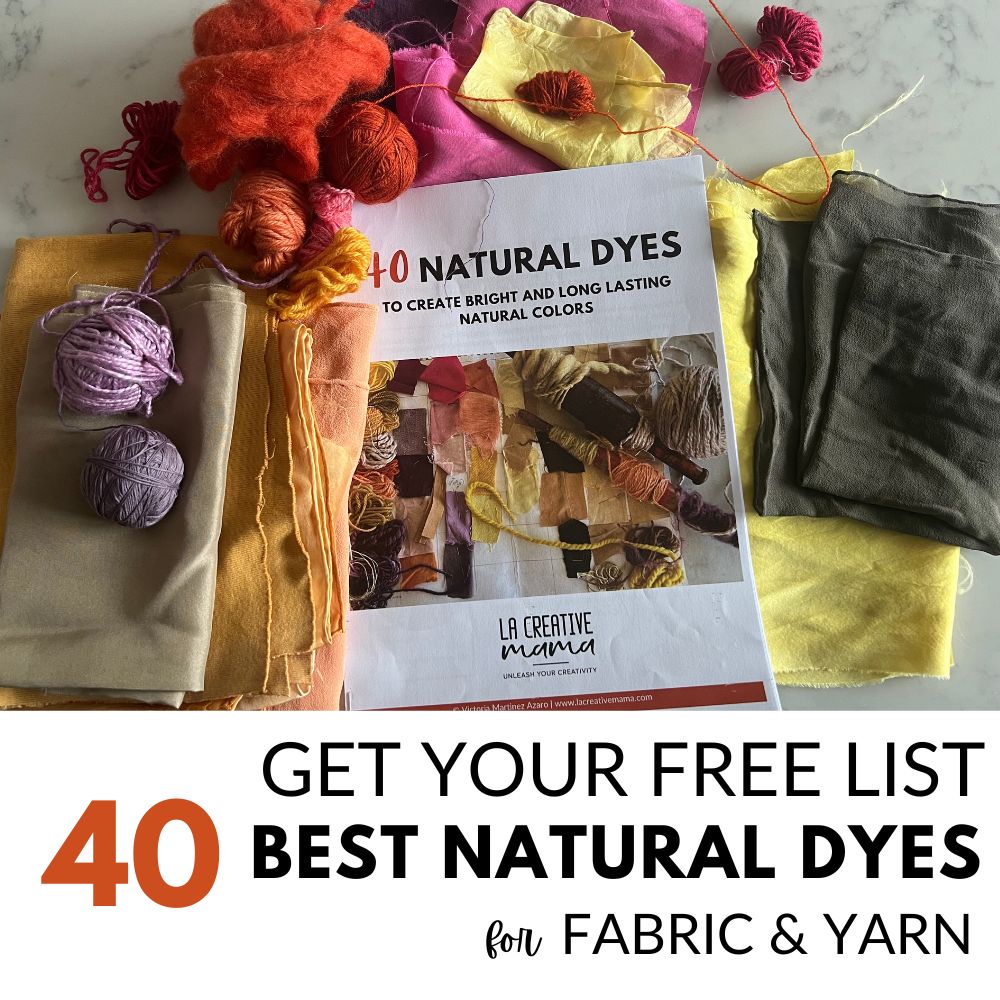Hi Creative Mamas! Would you like to discover which are the best 40 natural dyes to use to dye fabric and yarn so that you can create beautiful natural color that is bright and that last for a very long time!
Watch this little video to find out about the amazing FREE dyes list we have prepared for you!
From walnuts to cochineal, these dyes can be used in many ways and will deliver a variety of different colors and shades.
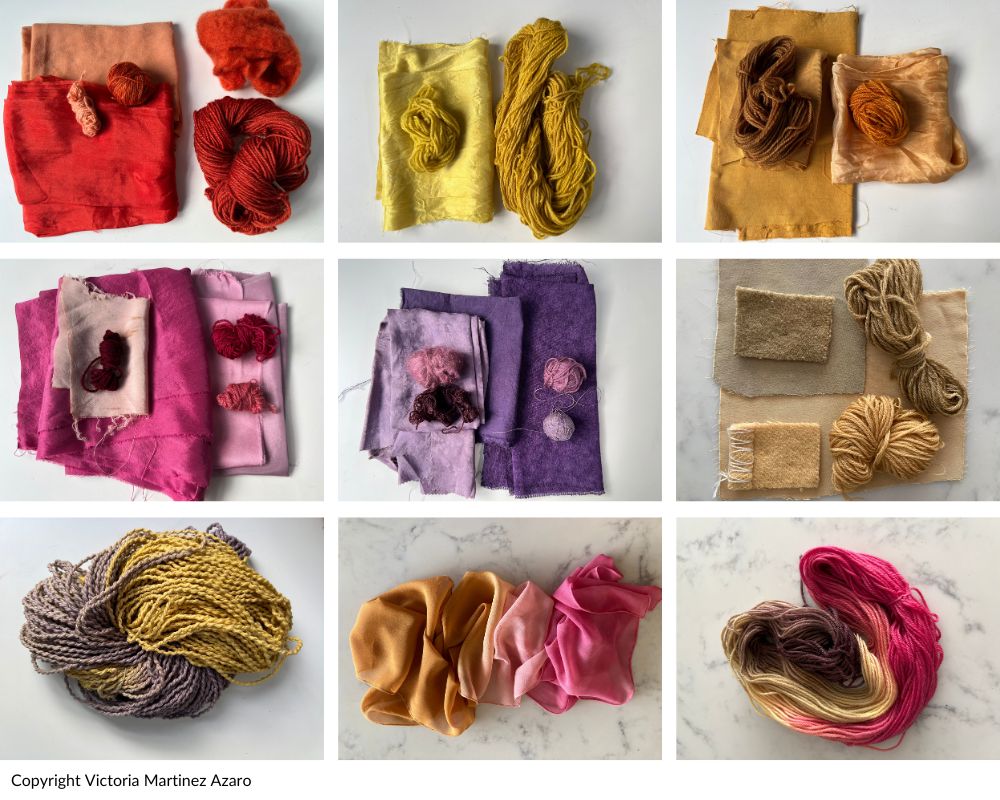
Making natural colors/botanical colors
Dyeing with natural ingredients and making natural colors is not only healthier for you and the environment, but also more eco-friendly than using chemical alternatives.
And the best part about it is that it’s fun and easy!
There’s no need for harmful chemicals or synthetic dyes when there are so many options available. However, you need to know that not all natural dyes are created equal.
This is because natural dyes are not as potent as synthetic dyes. You need to make sure that you are using the correct processes and applying the correct amount of each of the ingredients in the dyeing recipes.
Grab the FREE NATURAL DYES LIST
Complete the form below to download the FREE list of the best 40 dyes to use in natural dyeing! Save time and frustration!
My secret to create beautiful bright and lasting color every time is very simple:
Specific dyes + specific process = BEAUTIFUL BRIGHT & LASTING COLOR
I have a list of 10 natural dyes that I recommend to all my students to use as they start experimenting with natural dyeing.
I do this because I know that if they use this list of dyes they will be 100% satisfied with the amazing color results they will get.
Check out my Beginner’s Guide to Natural Dyes for the list of natural dyes that I recommend!
What are natural colors?
Natural colors or natural colorants are produced by natural dyes.
These dyes are natural colorants obtained from natural sources. They include a wide-variety of natural materials including vegetables, flower petals, leaves and animal products.
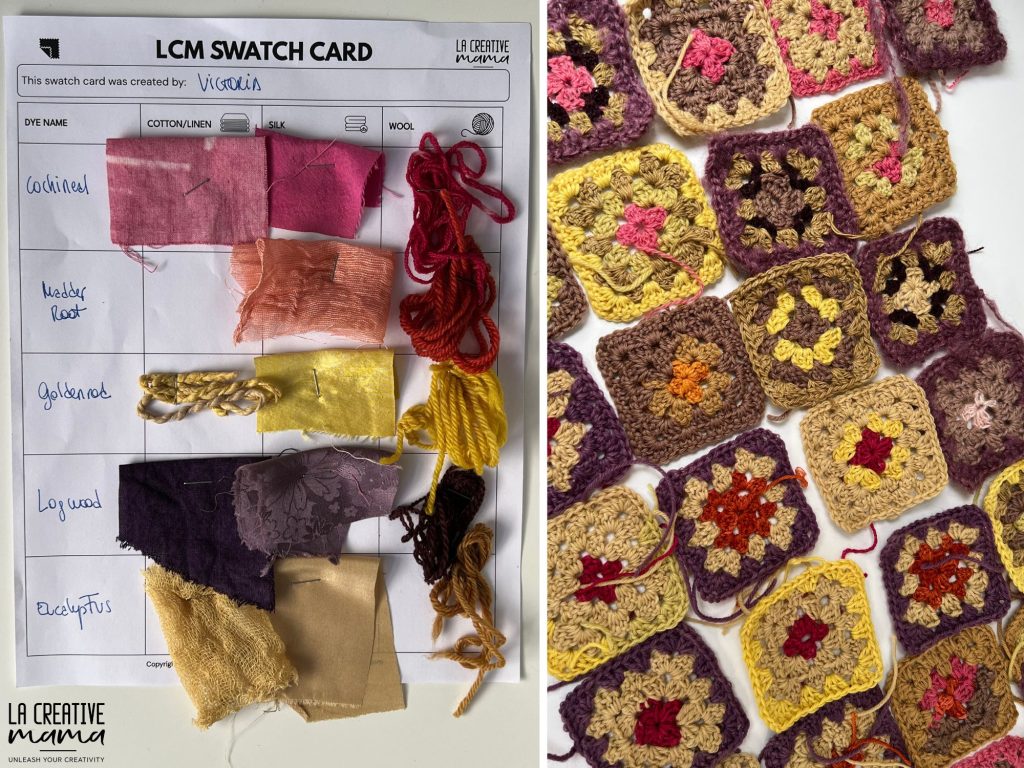
Using mordants in natural dyeing
Natural mordants include barks, tannins, lichens, tin, copper, alum and iron as well as natural fiber blends such as linen/ cotton which are known to create colors with natural fibers.
Due to the level of toxicity that some of these mordants have I only ever use Alum. You can read all about the different mordants and their application in natural dyeing here.
List of 40 plus natural dyes
I receive a lot of emails from my students asking questions about a lot of different natural dyes.
Also lot of people come to my live workshops wanting to have a go at natural dyeing with beetroot and carrots.
My response is always the same: PLEASE DONT!!!!!!
Even though there is a lot of info out there about these dyes and how quick and easy they are to use, the reality is that they just won’t last. They are not colorfast and they will fade away in no time.
Why spend your time creating colors that will wash away so fast when you could be spending the same amount of time with dyes that will deliver long lasting color for years to come?
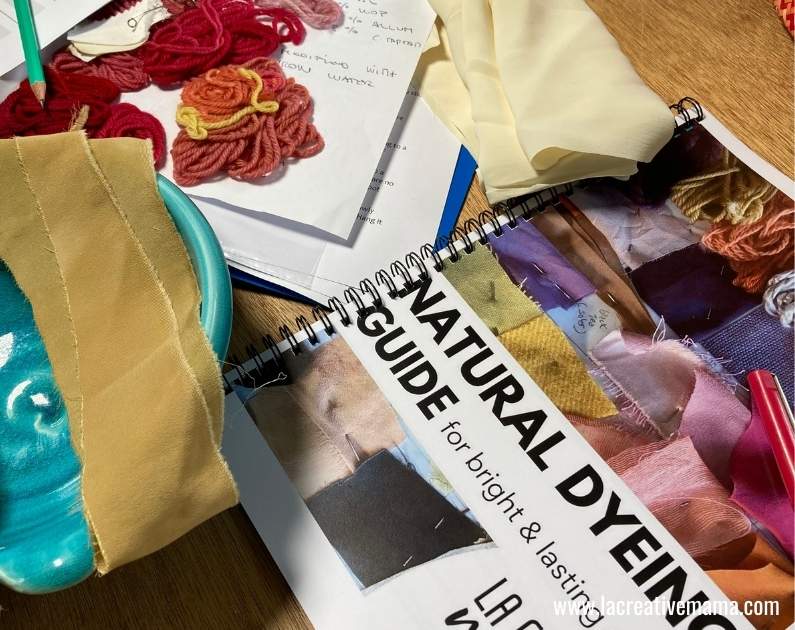
So, in this post I want to share with you a wider range of natural dyes options so that if you want to go beyond my top 10 best natural dyes, you can have another set of dyes to experiment with in your natural dyeing practice.
This list of dyes will also deliver very good results as long as you follow the 8 step process for natural dyeing.
I have experimented myself (or my dyer colleagues have) with all the dyes in this list and that’s why I am comfortable sharing this list with you 🙂
Using Solar dyeing with the natural dyes list
You can totally apply this list of dyes to the solar dyeing Process. The beautiful thing about solar dyeing is that it’s a great slow craft to do with kids. they will love seeing the color change day after day 🙂
Natural Dye Chart
This is my go to natural dye chart of colors that I normally work with. All these natural colors were obtained through my 10 favorite natural dyes.

Let’s explore other natural dye options 🙂
Plant and animal derived dyes
This dyes list includes both dye plants (flowers, barks and leaves) and animal derived natural dyes. It also includes dyes that can be used without mordants.
Important Note: I refer to the colors obtained with these dyes assuming that you are mordanting with Alum.
If you were to use another mordant such as copper or tin the resulting colors will be different.
1- Walnut (Juglans regia)
Walnut is a great dye which produces different shades of brown depending on how long its boiled, ranging from light brown to almost black.
The photo below shows the background wool fabric which was eco printed with leaves and then submerged for 1 hour in a walnut dye bath. The results are a dark green because the eco print included rusty nails and it modified the brown from the walnut dye.

2-Sumac (Rhus coriaria)
Sumac comes as a powdered dyestuff from the bark of the sumac tree. This extract is a great source of tannin so it acts as a mordant as well. Sumac dye creates a lovely tone of pink.
3-Turmeric (Curcuma longa)
Turmeric is a natural yellow-orange dye that most of us use in our kitchens. It creates orange shades that range from light to dark depending on how long you dye for and the mordant applied. Turmeric will produce natural yellow and gold tones.
NOTE: Tumeric is not very colorfast so I will only use it in combination with other dyes.In the photo below you can see a sample of silk and wool dyed with tumeric and madder.

4-Brazilwood (Caesalpinia echinata)
Brazilwood is one of the red natural dyes that can be used for natural dying. This natural dye produces a lot of red color when it’s extracted from the wood and bark.
5-Birch (Betula Pendula)
When using Birch you need to use the bark. This dye produces a deep purply- red natural shades on yarn or fabrics.
6-St John’s Wort (Hypericum perforatum)
St John’s Wort produces a lot of yellow color when it’s extracted from the flowers, this natural dye is best used with natural mordants, especially barks and tannins. Some books claim that it can deliver a pink color but it hasn’t been my experience so far)
7-Oak (Quercus Robur and Quercus ilex)
Oak dye is extracted from oak tree bark , leaves and acorns and produce brown tones when used on natural fabrics such as cotton or linen.
I refer to this dye as Acorn and I use it a lot specially between February and April here in New Zealand. This post illustrates how you can easily transform the gold brown into black by the help of iron water as a color modifier.

7-Annato seeds (Bixa orellana)
Annato seeds produces a natural orange dye which translates into a range of natural brown and orange tones when fabric or yarn is dyed.
8-Chestnut oak (Quercus castaneifolia)
This natural dye produces orange and red shades on natural fibers. It’s a lovely dye to work with 🙂
9-Black tea (Camelia sinensis)
Black tea produces a beautiful deep brown and the beauty of it is that you don’t need to use a mordant due to the amount of tannin present in the dye itself. Check out this step by step tutorial on how to dye with black tea.

10-Pomegranate (Punica granatum)
This natural dye will produce a lovely yellow color as well as natural shades of orange.
11- Coffee (Coffea Arabica)
The natural dye can be extracted from the natural coffee beans to produce natural brown tones. Great dye to make use of old coffee beans or re use the left over coffee grind in the morning 🙂
12- Indigo (Indigofera suffruticosa and Indigofera tinctoria )
Indigo is a natural blue dye that produces beautiful shades of blue and doesn’t need the assistance of any mordants. Indigo is a totally different dye and requires a different process than most dyes do.
In the photo below you can see a piece of silk dyed with indigo and silk and the silk and yarn on top have been dyed with onion skins.

11- Cochineal natural dye (Dactylopius coccus)
This dye is obtained from cochineal insects which are found on prickly pear cactus. The natural dye produces a range of natural reds and bright pinks. Check out the full step by step tutorial on how to dye using cochineal bugs.
The photo below illustrates the range of pink colors that are available to us by using cochineal dye.
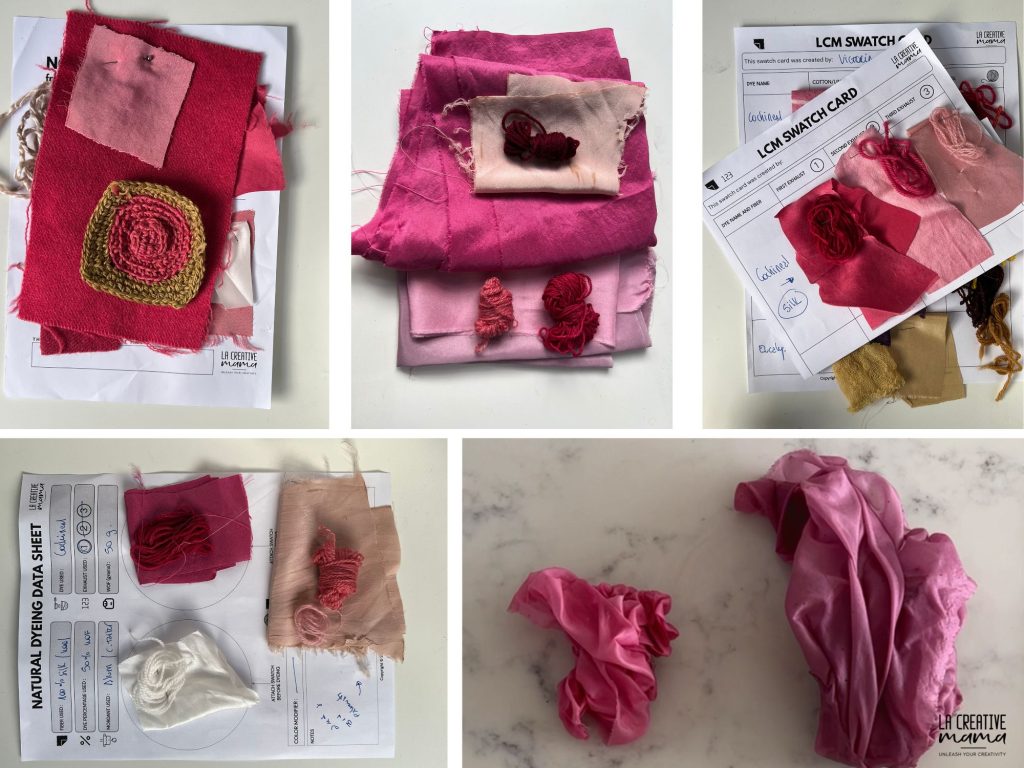
12- Oak galls (Quercus infectoria)
Oak dye produces brown to deep purple shades on natural fibers. It’s also used as a mordant in cellulose fibers due to its rich tannin content.
13-Madder (Rubia tinctorium)
Madder dye belongs to the Rubiaceae family of plants. It’s known since antiquity due to its use as a natural textile dye. The color it produces ranges from pink to deep red and orange shades when it’s extracted from the roots. I love this dye so much!
The photo below shows a variety of naturally dyed yarn, roving and silk produced by using madder at different ratios.
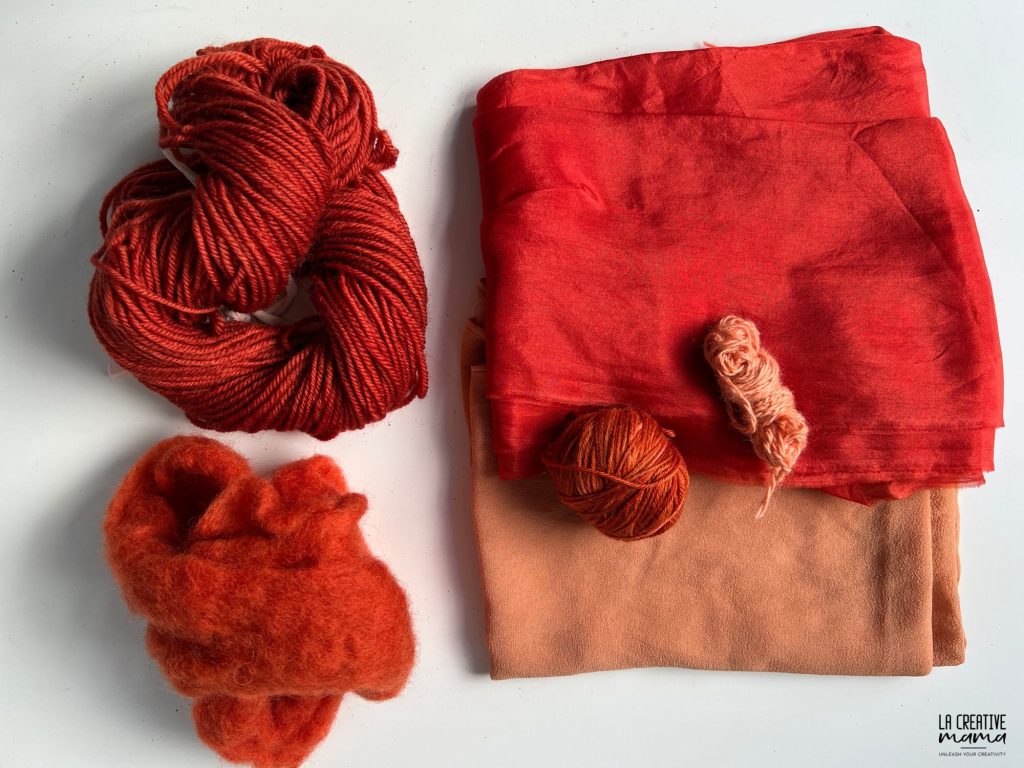
14- Onion skins (Allium cepa)
This natural dye produces bright yellows and brown tones depending on how long the natural dye is boiled and which onion variety you use. It’s one of the easiest natural dyes for beginners to try out because we all have it in our homes 🙂
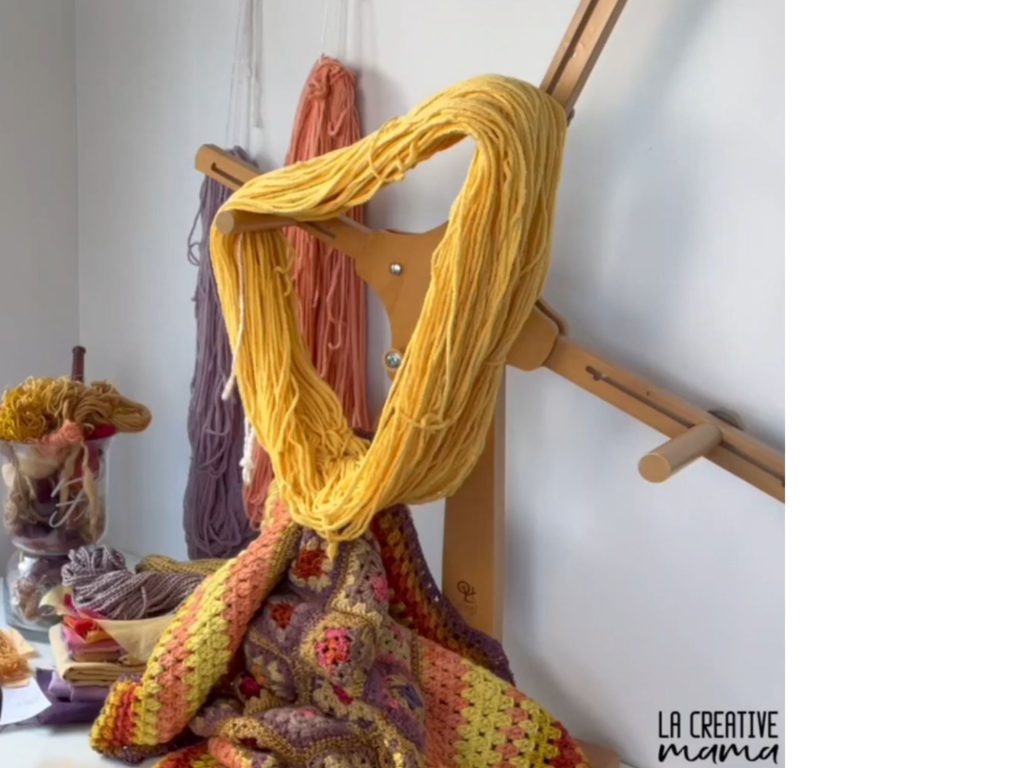
This is a step by step tutorial on how to dye using onion skins.
15-Fusticwood (Clorophora tinctorium)
Fusticwood produces a variety of yellows. Fustic is an excellent dye for over-dyeing, as it produces good greens with woad and a good black with logwood and iron.
The illustration below shows the fusticwood shavings which I used to dye 100% merino wool and 100% silk yarn. As you can see the same dye bath will have different effects based on the fiber that you are dyeing.

16-Safflower (Carthamus tinctorius)
Safflower produces natural orange and yellow tones. You can achieve natural brown shades using iron as a natural mordant.
17-Cutch (Acacia catechu)
Cutch produces yellow and dark brown shades on natural fabrics. It’s extracted from the natural bark of the tree.
18- Osage (Maclura tinctoria)
Osage natural dye produces natural bright yellow and shades of orange on natural fabrics. It’s extracted from the natural bark of the tree.
19- Sappanwood / Eastern Brazilwood (Caesalpinia sappan)
This dye produces natural shades of red to orange natural tones. The wood is used for carving and furniture making, it’s extracted from the natural heartwood of the tree.
20-Alkanet (Anchusa tinctoria)
The colors produced by this natural dye are beautiful natural shades of pink to purple. The dye is extracted from the natural root of the plant.
The photo below shows a piece of silk dyed with alkanet. As you can see it has delivered a deep purple color. The bits of yarn on the side as madder (red) and the brown yarn is a combination of dyer’s chamomile which was overdyed with logwood.

21- Logwood (Haematoxylum campechianum)
Logwood natural dye produces natural shades of red to purple natural tones on natural fabrics. It’s extracted from the natural heartwood of the tree .
The photo below shows 2 different pieces of silk dyed with logwood. It will deliver different shades of purple.
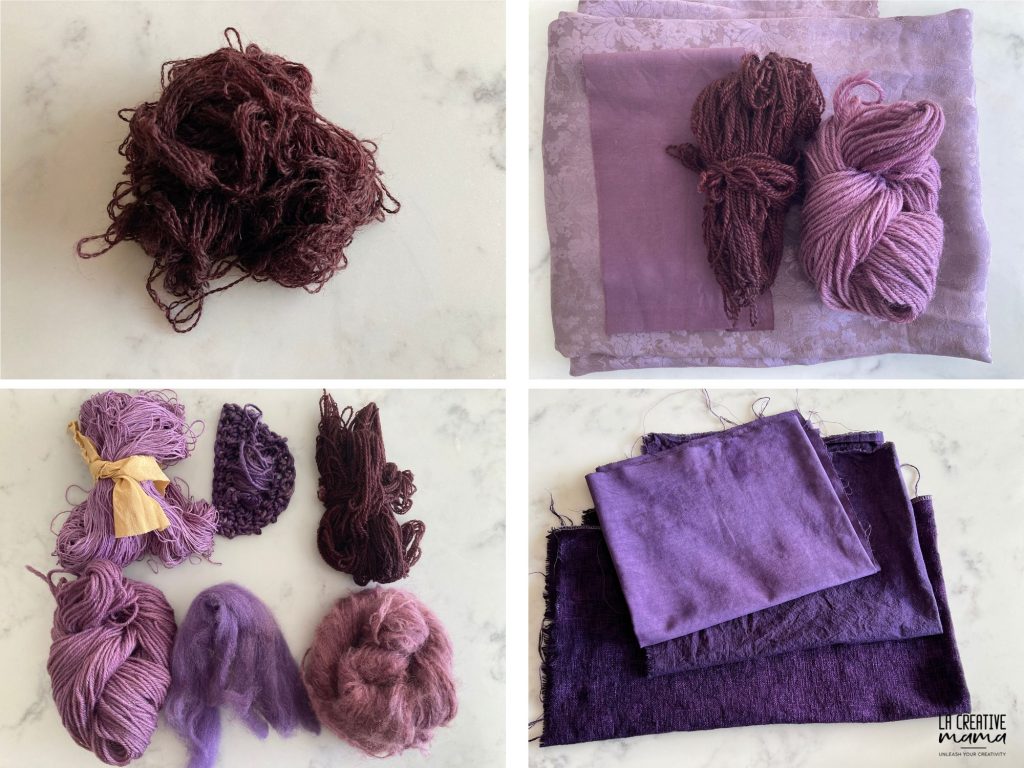
22-Woad (Isatis tinctoria)
The natural colors produced by this woad range from rich greens to browns and purples natural tones. It’s extracted from the natural leaves of the plant.
My experience with this dye is that it’s quite tricky to work with.
23-Marigold (Tagetes)
The colors produced by this natural dye are natural yellow to natural orange shades, depending on how long it’s boiled. It’s extracted from the natural flowers of the plant.
24-Dyer’s Chamomile (Anthemis tinctoria)
The colors produced by this flower dye is a bright natural yellow. It’s extracted from the natural flowers of the plant but I normally use the leaves and I get as much color from them as from the flowers.
I grow Dyer’s Chamomile in my garden and I love working with this plant. Here is an example of the bright yellow that these plants give me season after season.
The dyer’s chamomile is the middle yellow, the purple is logwood and the coffee color is actually coffee dye.

25-Daffodil (Narcissus naturalis)
Daffodil produce a lovely range of yellow tones depending on how long it’s boiled. It’s extracted from the natural flowers and leaves of the plant.
26-Fern (Dryopteris filix -mas)
The natural colors produced by these fern leaves range from light browns to very dark browns. They are abundant here in New Zealand.
27-Ivy (Hedera helix)
The natural colors produced by Ivy range from natural shades of deep yellow to intense browns. It’s extracted from the natural leaves of the plant. I have only experimented with the leaves but you can also extract red color from the stems.
28-Weld (Reseda naturalis)
The good thing about weld is that you can use the whole plant to extract color and will deliver beautiful shades of natural yellow. I grow weld in my garden and its great because once it ‘s establish it self seeds.
29- Lac (Tectona naturalis)
Lac extract yields crimsons to burgundy reds to deep purples. The colorant is similar to cochineal but colors achieved are warmer and softer. I have only ever used the extract form of this dye.
30-Quebracho (Schinopsis lorentzii )
The natural color produced by the quebracho tree bark is a deep brick color similar to the one you can get from madder. I have only used the powder form of this natural dye in my natural dyebath and I played around with the ratios.
I love this dye beacause the quebracho trees are from the north of Argentina (my birth country) and I used to love looking at the red tree trunks when I was little.
31-Henna (Lawsonia naturalis)
If you want natural brown, tan orange and natural golds that are rich to deep in natural tone henna is your natural dye. This is a dye that is worth trying at some stage.
32- Avocado skins and pits (Persea americana)
Avocado skins and pits will produce beautiful shades of pinks as well as blush and soft golds. One of my favorite dyes to start with. Read here for a full tutorial on how to dye with avocado dye.
The photo below illustrates the type of color that both avocados and onions can deliver. The blush and soft pinks are avocado dyed fibers and the coppers and yellows are from onion skins.

33- Avocado leaves (Persea americana)
Avocado leaves will deliver a strong deep yellow and will vary depending on the soil that the tree is growing on.
34-Eucalyptus (Eucalyptus naturalis)
I love to use Eucalyptus leaves from my local area which is Auckland, New Zealand because they produce different tones of bright deep golden brown.
There is a huge variety of Eucalyptus and they all deliver different colors. Try the one in your area and I am sure whatever shade of gold or red you get you will be super happy!

The photo above shows silk and wool dyed with eucalyptus. The green color was obtained by overdyeing the fiber in an iron water bath.
35-Yerba Mate (Ilex paraguarensis)
This is the natural green dye! Dyeing with yerba mate has been a great way to not only use my national drink for my crafts but also to get a lovely green.
Greens are hard to create in natural dyeing and we usually use a yellow dye which is overdyed with a blue bath of indigo.
So obtaining green using yerba mate has been a great help!
The phot below shows my mate dyed silk and wools but I am not getting consistent green results all the time so that’s why the mate dye has not been featured inside my Natural Dyeing courses yet!
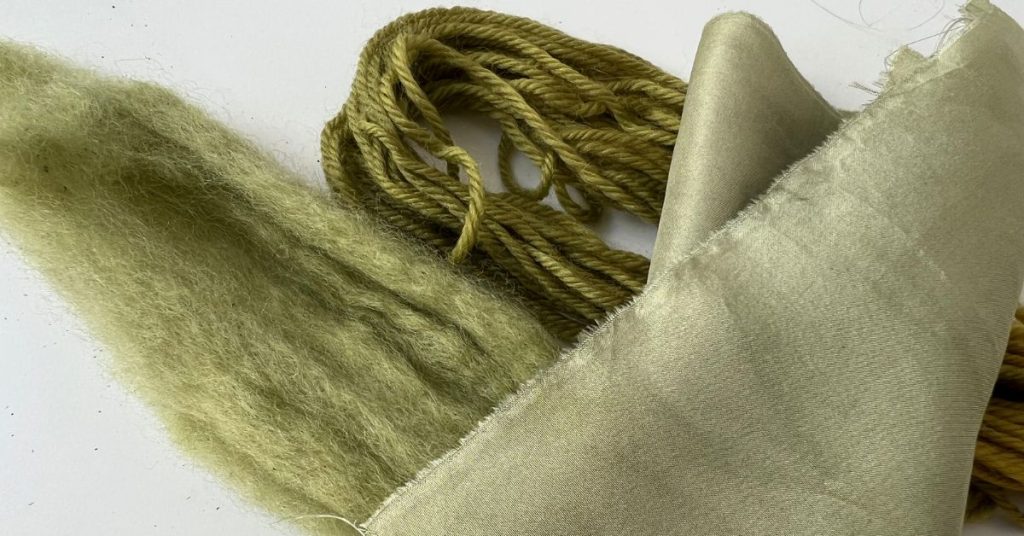
36- Elder (Sambucus naturalis)
The natural colors produced by Elder leaves are a variety of yellows and its a lovely dye to work with. The best results are obtained by dyeing with fresh leaves.
37- Gorse (Ulex naturalis)
You can get beautiful yellows from Gorse and depending where you are in the world it’s a very accessible plant to access. Give it a try!
38-Goldenrod (Solidago naturalis)
This natural dye is best extracted from the natural flowers and leaves. You can also extract it with seeds they are easier to get hold of than the flowers. The natural colors produced by goldenrod range mainly in yellow tones.
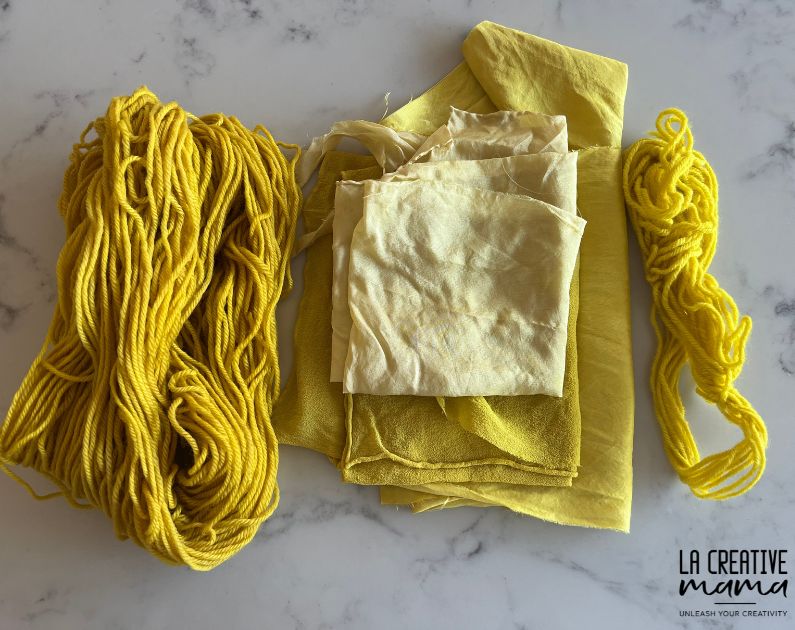
39-Coreopsis (Coreopsis naturalis)
This natural dye can be used to create yellow, browns, and even natural reds depending on the conditions where you are dyeing. It’s easy to access for most people so give it a try!

I love using coreopsis in eco printing fabric as in the photo above. I grow these plants in my garden so I use them a lot.
I particularly like how they print on silk and on paper as well. Check out how I use coreopsis in eco printing in paper.
40-Blackberry (Rubus fruticosus)
Blackberries natural dyes will produce natural shades of purples to browns and reds. You can create a natural brown by natural dyeing with Blackberry juice or you can use the actual purple berries themselves.
Note: I have included Blackberries here because I get a lot of questions about this dye , however it’s my least favorite dye since I think the results are not worth the effort.
41-Nettle (Urtica naturalis)
Nettle dyes will produce shades of yellow and greens. In my experience the results are very light and again, its not a favorite dye for me to use 🙂
Download the FREE Natural Dyes LIST
Drying your dyes for later use
It’s useful to be able to dry plants and animal derived dyes for later use. NOTE: The plants need to be totally dried otherwise they can grow mold.
To dry flowers I love to make little bunches, tie them and hung them upside down. I also sometimes space them out on a tray and let them dry outside in the sun.
Then when they are totally dehydrated I put them in a paper bag or another container with small holes.

I hope you have found this list useful and please reach out with any questions that you may have and remember: NO CARROTS! :)))))
Save this post to your favorite Pinterest board


